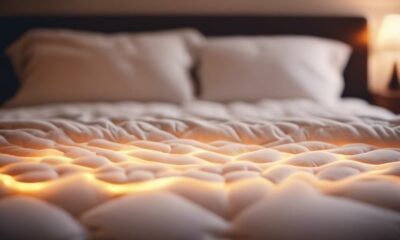Interior
Where Can I Get an Interior Car Wash
Just discovered the perfect spot in Houston for an exceptional interior car wash, with top-notch detailing services that will leave you amazed!
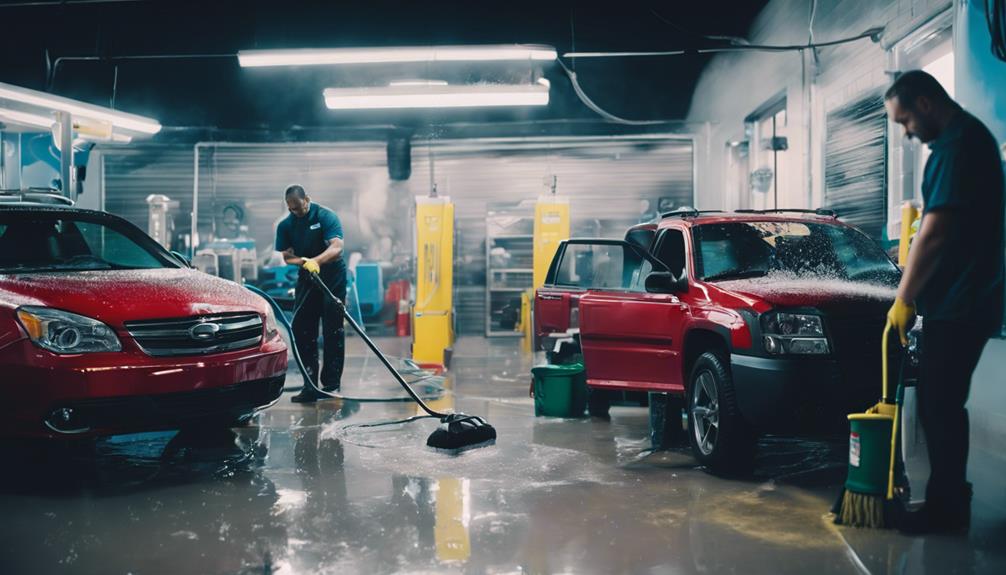
Are you in search of an outstanding interior car wash in Houston? YRK CUSTOMZ offers top-notch interior detailing services for cars and SUVs starting at just $86.40. This service includes thorough cleaning of seats, carpets, and dashboards, ensuring a fresh and healthy environment. Car Toys also provides interior detailing with O3-Ozone treatment, while Indris Car SPA specializes in sedans and coupes at $172.50. You can also enjoy perks like leather cleaning and tire shining for that extra sparkle. These detailed services range from $75 to $250, catering to your budget and specific needs. Are you ready to enhance your car’s interior cleanliness and aesthetics?
Key Takeaways
- YRK CUSTOMZ offers interior detailing for cars and SUVs at a discounted price of $86.40.
- Car Toys provides an interior detailing package with O3-Ozone treatment.
- Indris Car SPA specializes in sedan/coupe detailing services at a discounted price.
- Xcellent Mobile Services offers a 5.0-star rated exterior detail package for $100.
- Quoontry provides a combined interior and exterior detailing service at a 31% discount for $138.
Houston's Premier Interior Car Wash Services

Seeking high-quality interior car wash services in Houston? When it comes to keeping your car's interior clean and fresh, focusing on interior cleaning and floor mats is essential. Houston offers a variety of options to cater to your car's needs.
YRK CUSTOMZ, located just 17.6 miles from Houston, provides interior detailing for cars and SUVs at a discounted price of $86.40. This service includes thorough cleaning of your vehicle's interior, ensuring that every nook and cranny is spotless.
Additionally, Car Toys, situated 17.1 miles from Houston, offers an interior detailing package with O3-Ozone treatment, perfect for eliminating odors and bacteria.
Don't forget about your floor mats, as they can accumulate dirt and grime quickly. Indris Car SPA, located in Houston, provides sedan/coupe detailing services at a discounted price of $172.50, ensuring that your floor mats are cleaned and restored to their original condition.
Keeping your car's interior clean not only enhances its appearance but also promotes a healthier environment for you and your passengers.
Professional Interior Detailing Near You
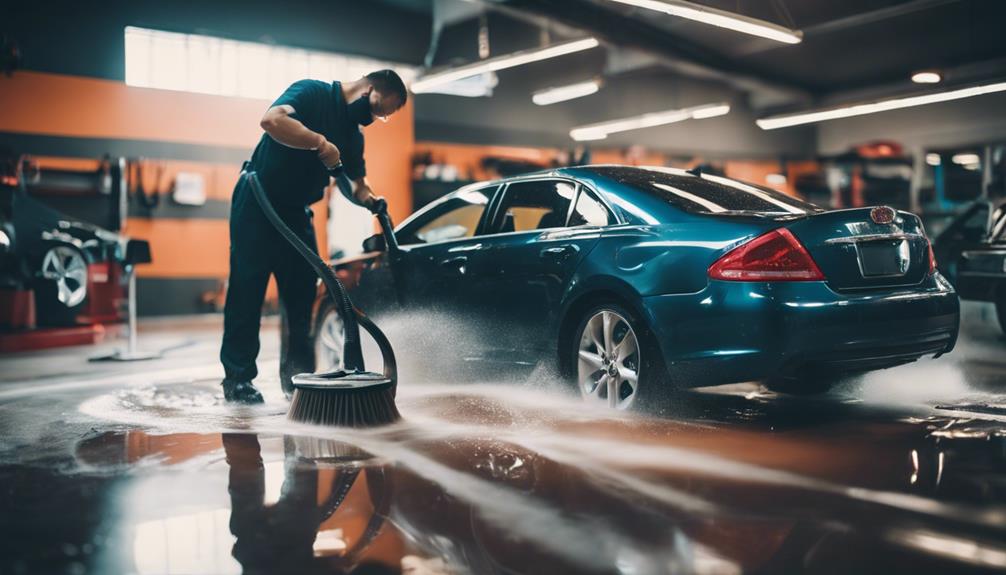
Looking for expert interior detailing services near Houston? Professional interior detailing goes beyond a regular car wash, focusing on a thorough clean of your vehicle's interior. Top-rated auto detailing services in Houston offer detailed interior cleaning for cars and SUVs, ensuring your vehicle looks and feels fresh.
These services typically include meticulous cleaning of seats, carpets, and the dashboard, leaving no corner untouched. Prices for interior detailing can vary, ranging from $75 to $250, with some providers offering discounts for bundled services. Additionally, many places provide extra perks such as leather cleaning, trim shining, and tire shining to give your car that extra sparkle.
Conveniently located in or near Houston, these interior detailing locations make it easy for you to keep your vehicle in top condition. When searching for professional interior detailing near you, these services are a great option to keep your car looking its best inside and out.
Expert Interior Car Cleaning Solutions

For a thorough clean inside your vehicle, consider expert interior car cleaning solutions that encompass meticulous vacuuming, shampooing seats, carpets, and floor mats, along with cleaning plastic and leather surfaces. These services go beyond a simple wipe down, ensuring a deep cleanse to remove dirt, stains, and odors from every nook and cranny of your car's interior. Expert cleaners will often start by removing all loose items from your vehicle before diving into the cleaning process. They pay special attention to details like streak-free windows and mirrors, using specialized equipment to achieve a meticulous finish.
Prices for these interior cleaning services can vary based on the size and condition of your vehicle. Typically, small vehicles may range from $200 to $240, while larger vehicles could cost between $260 and $340. Some providers even offer mini-interior detail packages for regular upkeep, while others provide thorough cleaning processes to restore your interior to its best condition. These expert services use trusted brands and tools to tackle different cleaning situations efficiently, ensuring your car looks and feels fresh and clean.
Convenient Interior Car Wash Options

Consider exploring a variety of convenient options for interior car wash services to keep your vehicle looking fresh and clean. If you're in Houston, you can check out YRK CUSTOMZ, located just 17.6 miles away, offering detailed interior cleaning for cars and SUVs.
For a mobile exterior detail package for your car or small SUV, Xcellent Mobile Services in Houston could be a great choice.
Car Toys provides an interior detailing package with O3-Ozone treatment, ensuring a thorough clean for your vehicle.
If you have a sedan or coupe, Indris Car SPA specializes in detailing services tailored to these types of vehicles in Houston.
Another option is Quoontry, which is only 5.3 miles from Houston and offers detailed interior and exterior detailing services.
With these convenient options, keeping your car's interior looking spotless has never been easier.
Top-Rated Interior Car Wash Providers
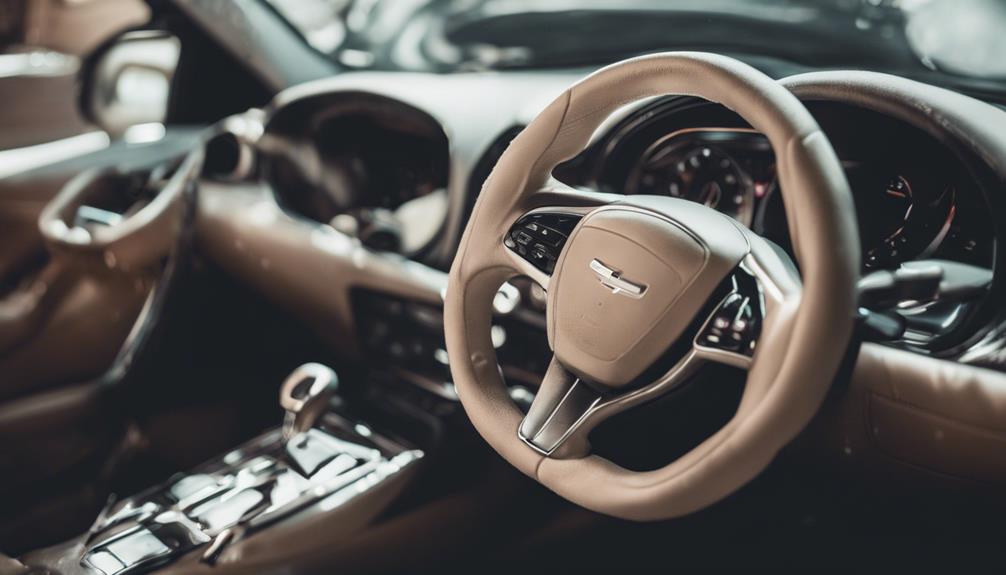
Exploring the top-rated interior car wash providers can help you find the ideal service for keeping your vehicle in pristine condition. YRK CUSTOMZ stands out with a 4.7-star rating and a discounted price of $86.40 for their interior detailing services for cars and SUVs.
If you prefer a mobile service, Xcellent Mobile Services might be the perfect choice, offering a flawless 5.0-star rating for their exterior detail package for cars or small SUVs at a discounted price of $100.
Car Toys, with a 3.6-star rating, provides an interior detailing package that includes O3-Ozone treatment, all for a discounted price of $79.99.
Looking for sedan/coupe detailing? Indris Car SPA offers this service with a 31% discount, priced at $172.50.
For a combined interior and exterior detailing service, Quoontry could be your go-to, with a 31% discount, priced at $138. Make sure to choose the provider that best suits your car's needs and your budget to keep it looking its best.
Frequently Asked Questions
How Can I Clean My Car Interior Cheaply?
To clean your car interior cheaply, utilize household items like vinegar, baking soda, and dish soap. These DIY solutions work wonders on stains, odors, and grime.
Regular vacuuming, wiping, and spot treating keep your car tidy without breaking the bank. Opt for microfiber cloths, soft brushes, and gentle cleaners to protect surfaces.
Look for budget-friendly cleaning kits or multipurpose cleaners for a fresh interior on a dime.
What Can I Wash the Interior of My Car With?
You can wash the interior of your car with mild soap, water, and specialized cleaners. Use microfiber cloths or brushes on surfaces like seats, dashboard, and door panels. Avoid harsh chemicals to prevent damage.
Vacuum before cleaning to remove dirt and debris. Regular maintenance preserves your car's value and condition.
How Much Is Car Detailing in Houston?
Car detailing prices in Houston vary from $56.25 to $172.50, including discounts. Popular services like interior detailing and exterior wash packages are available at reduced rates. Different centers offer various service levels and pricing options. Discounts and promotions help make car detailing more affordable.
Prices can differ based on the vehicle type and detailing needed. Check out the deals in Houston to get your car looking fresh without breaking the bank!
How Often Should You Wash Your Car Interior?
You should wash your car's interior every 1-3 months for regular maintenance. If pets or kids are frequent passengers, consider cleaning more often to remove dirt, hair, and spills.
High-traffic vehicles or those with odors might benefit from washing every 2-4 weeks to keep things fresh. Professional detailing services offer deep cleaning, including carpet shampooing and leather conditioning.
Regular interior washing not only enhances looks but also guarantees a healthier driving experience.
Conclusion
In search of a fantastic interior car wash in Houston? Your quest ends here! Our top-rated providers offer professional interior detailing services that will leave your car looking spotless and fresh.
With convenient options available near you, getting your car cleaned has never been easier. Don't hesitate any longer to give your car the TLC it deserves.
Book an interior car wash today and experience the difference for yourself!
Interior
Does Interior Paint Increase Home Value
Yearning to discover how interior paint can skyrocket your home's value? Get ready to unlock the secrets that will transform your space!

Interior paint plays a crucial role in increasing the value of your home by impressing potential buyers with a cohesive, fresh appearance. The color palettes you select have a long-lasting impact on how your home is perceived, influencing its attractiveness and market value. Choosing high-quality paint and strategic color combinations, such as neutrals, can significantly enhance the value of your property. Additionally, remember to update your interior paint every 7-8 years to maintain that fresh, welcoming atmosphere. Investing in top-notch paint and thoughtful color choices can greatly improve your home’s value and overall visual appeal. Are you ready to enhance the value of your home?
Key Takeaways
- Neutral colors and consistent schemes boost perceived value.
- Quality professional paint jobs command higher prices.
- Regular repainting every 7-8 years enhances home appeal.
- Strategic color choices significantly impact home value.
- Fresh, neutral paint increases space perception and curb appeal.
Importance of Interior Paint in Home Value
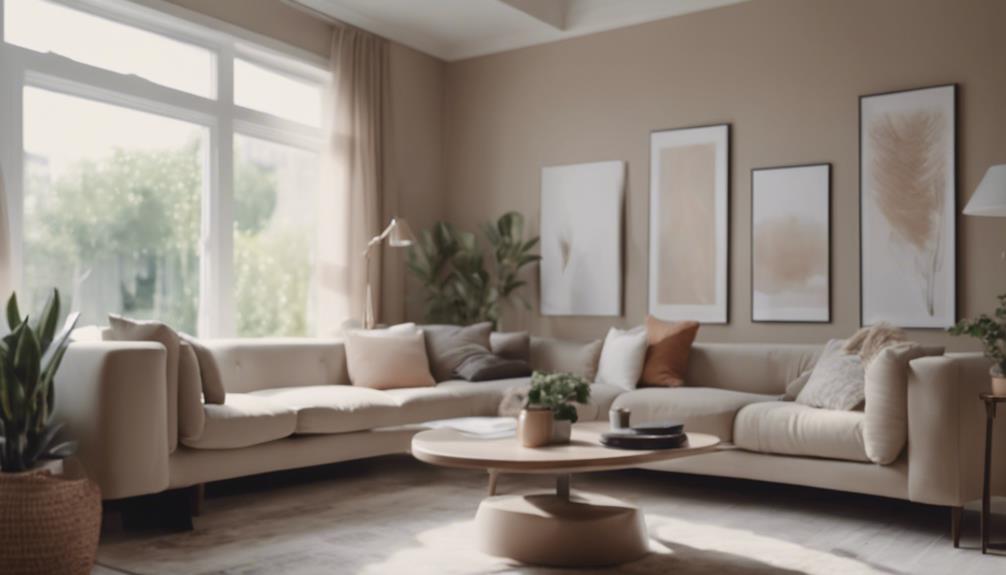
When contemplating the importance of interior paint in determining home value, it's crucial to understand its direct impact on potential buyers' perceptions and the overall financial return on investment.
The colors you choose to paint your walls can greatly influence how buyers view your home. A fresh coat of paint can enhance the perceived value of your home, showing that you have taken good care of the property. Consistent color schemes throughout the house can create a sense of flow and unity, making the space more appealing to potential buyers.
Additionally, repainting every 7-8 years with neutral colors can help maintain a fresh and updated look, maximizing the value of your home. Neutral colors have broad appeal and can make spaces appear larger, which is attractive to buyers. By investing in quality interior paint and choosing the right colors, you can significantly enhance the value of your home and make it more appealing to potential buyers.
Factors Influencing Home Value Through Paint
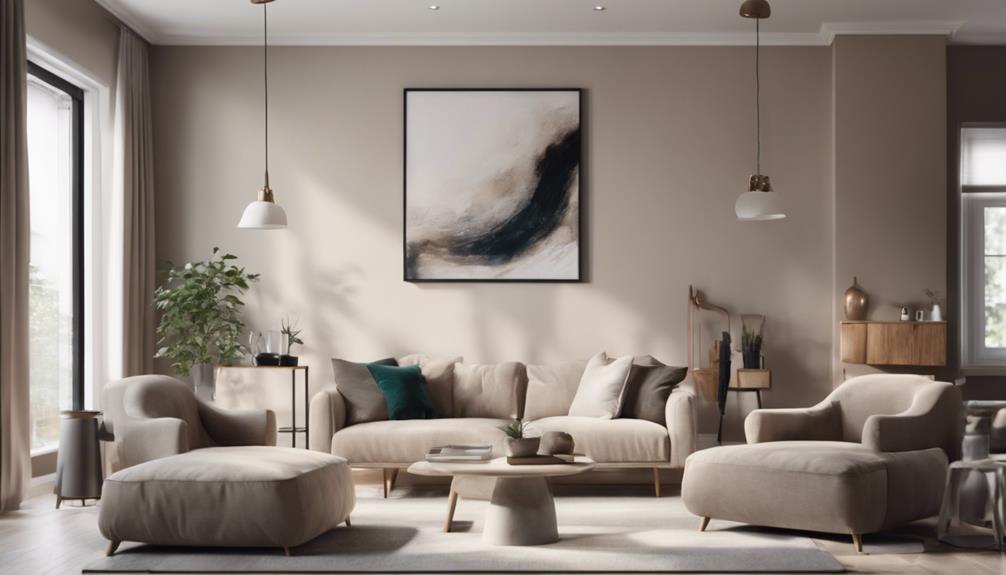
Factors that influence home value through paint include the choice of colors, the quality of the paint job, and the consistency of color schemes throughout the property. Neutral paint colors are highly recommended as they appeal to a broader range of buyers and can positively impact the perceived home value. Opting for professional interior paint jobs not only showcases good maintenance and care but also allows you to command higher prices in the real estate market. Consistent color schemes across your home can greatly improve flow and unity, enhancing the overall appeal and value of the property. Investing in quality interior paint can lead to a remarkable 107% return on investment, making it a wise choice for increasing your home's value. Take a look at the table below for a quick overview of how these factors can impact your home value:
| Factors to Take into Account | Impact on Home Value |
|---|---|
| Neutral Paint Colors | Positive |
| Professional Paint Jobs | Higher Prices |
| Consistent Color Schemes | Enhanced Appeal |
| Quality Interior Paint | Significant ROI |
Choosing the Right Colors for Value
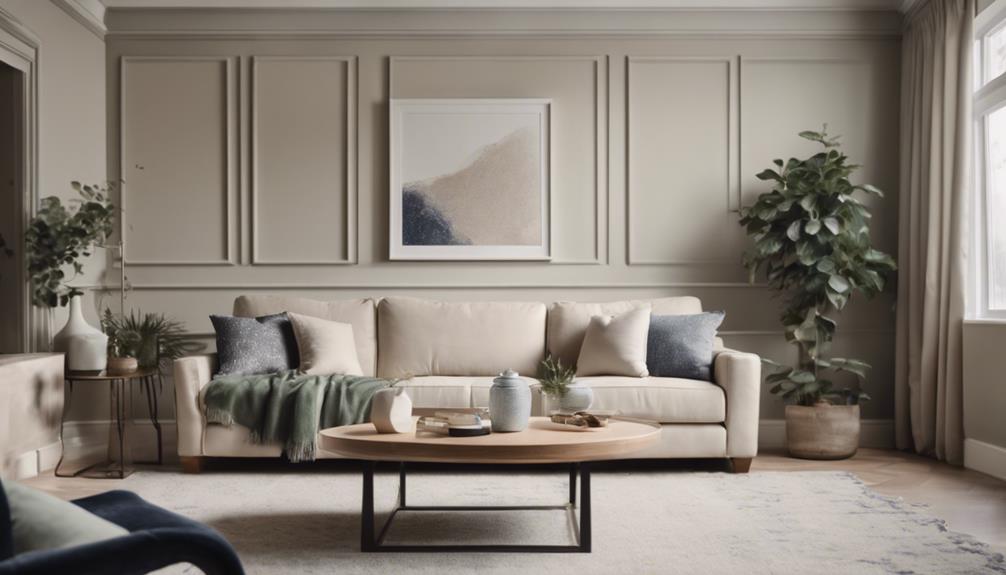
For maximizing your home's value through paint selection, prioritize choosing neutral shades like beige, tan, and greige. When selecting colors for value, keep in mind the impact they can have on your home's overall worth. Specific colors can make a significant difference in boosting your home's curb appeal and perceived value.
Consider the following tips for choosing the right paint colors:
- Darker Colors for Doors: Darker hues like gray, black, or navy blue on doors can add a touch of sophistication and elevate the asking price of your home.
- Light Blue-Gray Kitchens: Opting for light blue-gray tones in kitchens can make your home more appealing to potential buyers and potentially fetch higher selling prices.
- Bold Accent Colors: Using bold accent colors on doors or shutters can create visual interest and enhance the overall value of your property.
- Warm Neutrals: Warm neutrals such as tans and light taupe can help create a welcoming atmosphere and positively impact the perceived value of your home.
Enhancing Home Value With Fresh Paint
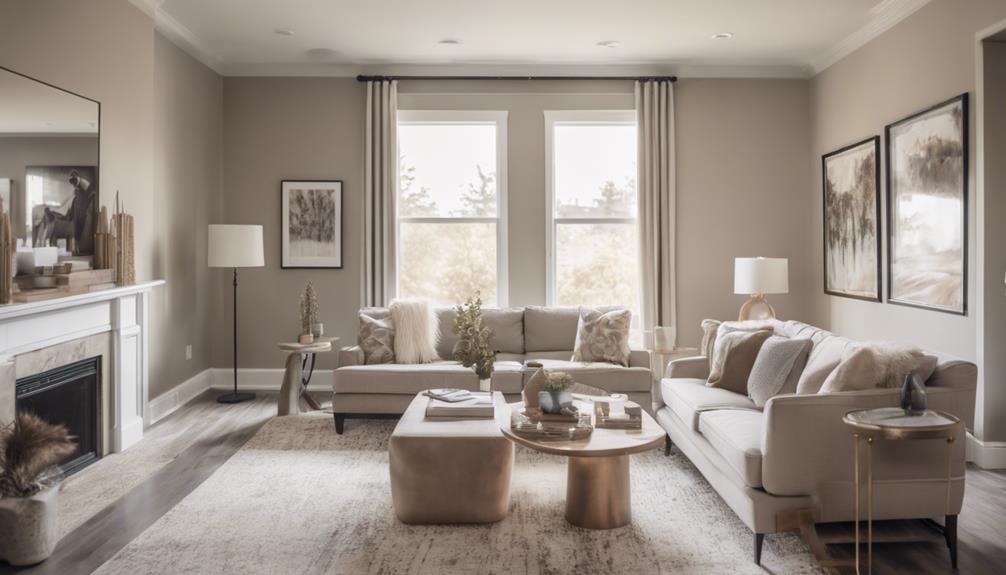
Enhancing your home's value with a fresh coat of paint can be a highly effective and lucrative investment. A fresh interior paint job not only refreshes the look of your home but also has the potential to increase its value substantially.
When potential buyers walk into a home with crisp, freshly painted walls, they immediately see a space that's well-cared for and move-in ready. This first impression can make a big difference in how they perceive the value of the property.
Whether you're painting a single room or giving the exterior a fresh new look, investing in painting as part of your home improvements can pay off in the long run. Fresh, neutral colors can make rooms appear more spacious and inviting, while a well-executed exterior paint job can boost curb appeal and attract more interest from potential buyers.
Maximizing ROI With Interior Paint

To maximize your return on investment with interior paint, consider the impact of color choices on perceived home value and overall appeal. When aiming to increase your home's ROI through painting, keep these key points in mind:
- Choose Neutral Colors: Opting for neutral tones can elevate the perceived value of your home, appealing to a wider range of potential buyers.
- Regular Maintenance: Repainting every 7-8 years is essential for maintaining your home's value and keeping it looking fresh and well-cared for.
- Consistent Color Schemes: Creating a consistent color palette throughout your house enhances flow and unity, making the space feel cohesive and inviting.
- Maximize Value: By strategically repainting key areas with attention to detail and quality, you can greatly enhance the overall value of your home.
Frequently Asked Questions
What Paint Color Increases Home Value?
Choosing the right paint color can greatly impact your home value. Neutral shades like light gray, beige, and greige are safe bets for increasing attractiveness. Dark colors such as charcoal gray, navy blue, or black on doors can elevate property prices.
Timeless exterior colors boost curb appeal, attracting buyers. Soft blues, greens, and yellows create inviting exteriors. Bold accent colors on doors or shutters add flair and value to your home.
Does Fresh Interior Paint Help Sell a House?
Fresh interior paint can work wonders when selling a house. Did you know that homes with freshly painted interiors tend to sell faster?
That's right! A fresh coat of paint can make your space look newer and more appealing to potential buyers. It's like giving your home a facelift that attracts more attention.
What Is the Best Interior Paint Color for Selling Your Home?
When choosing the best interior paint color to sell your home, go for neutral tones like grays, beiges, or greiges. These colors have broad appeal and can attract a wider range of potential buyers.
Soft blues and greens create a welcoming atmosphere, while bold accent colors on doors or shutters can increase your home's value.
How Much Value Does Paint Add?
Adding a fresh coat of interior paint to your home can greatly impact its value. On average, interior painting can increase your home's worth by $2,112! This high return on investment of 107% makes it a smart choice.
Selecting quality paint and cohesive color schemes can enhance the overall appeal of your home. With the right colors, you can even make your spaces feel larger or cozier, positively influencing your home's value.
Conclusion
So, next time you're thinking about sprucing up your home, remember that a fresh coat of interior paint can truly make a difference in its value.
Some may argue that paint is just a cosmetic change, but in reality, it can greatly enhance the overall appeal and marketability of your home.
Don't underestimate the power of paint when it comes to maximizing your return on investment!
Interior
Where to Wash Car Interior
Transform your car's interior with professional detailing services for a pristine finish that will exceed your expectations.

When you need to clean the interior of your car, consider professional interior detailing services. These services offer a thorough cleaning using specialized tools and techniques to achieve a flawless finish. They can restore the original color and texture of your car while also prolonging the lifespan of its interior components. You will be impressed by the results! If you are interested in learning more about premium cleaning options, odor removal techniques, or even leather repair services, keep exploring. It’s all about ensuring your car looks and feels its best both inside and out.
Key Takeaways
- Professional car interior cleaning services offer thorough vacuuming and sanitization for a pristine interior.
- Mobile car wash services provide convenient options with valet services for pick-up and drop-off.
- Membership plans for unlimited car washes simplify maintenance routines with various benefits.
- Consider reputation, range of services, pricing, and quality products when choosing a cleaning service.
- Regularly clean your car's interior by vacuuming, prompt stain removal, and implementing a cleaning schedule.
Professional Interior Detailing Services
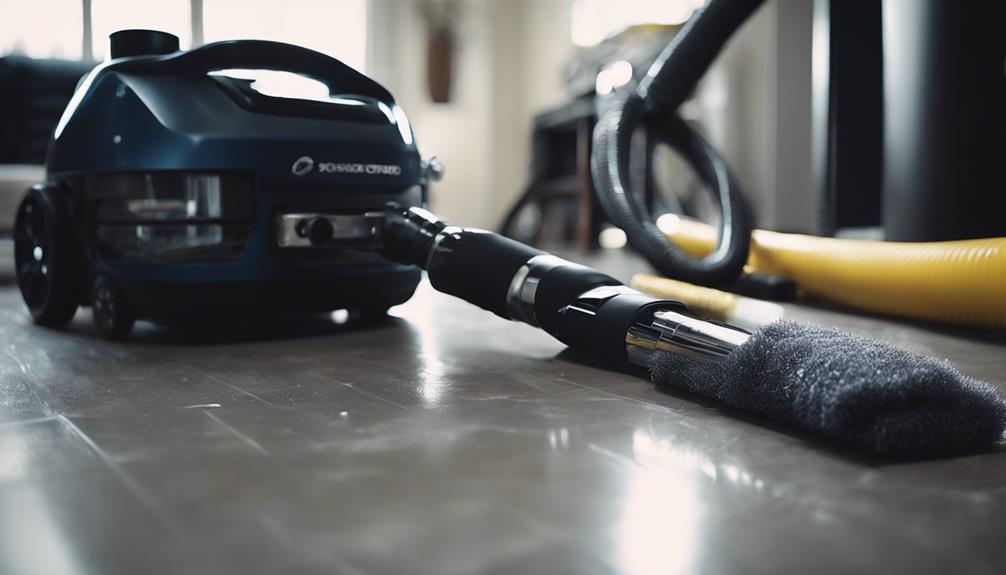
When you choose our expert interior detailing services, your car's interior will receive a high-quality treatment that includes thorough vacuuming, shampooing, and sanitization using specialized tools and techniques. Our detailing services are designed to provide a deep clean for your vehicle's interior, ensuring that every nook and cranny is free of dirt, dust, and debris. From the seats to the carpets and floor mats, we use professional-grade equipment to lift stains and restore freshness.
Our interior cleaning process goes beyond just surface dirt removal. We utilize a specialized pneumatic driven system for debris removal, a 212 ° F foam generator for deep fabric cleaning, and eco-friendly 212 ° F Euro dry-steam for sanitization. These advanced tools allow us to tackle tough stains and eliminate bacteria, leaving your car's interior not only clean but also hygienic.
With our detailing services, you can enjoy a pristine driving environment that looks and feels brand new. Trust us to provide the deep clean your car deserves.
Premium Interior Cleaning Options
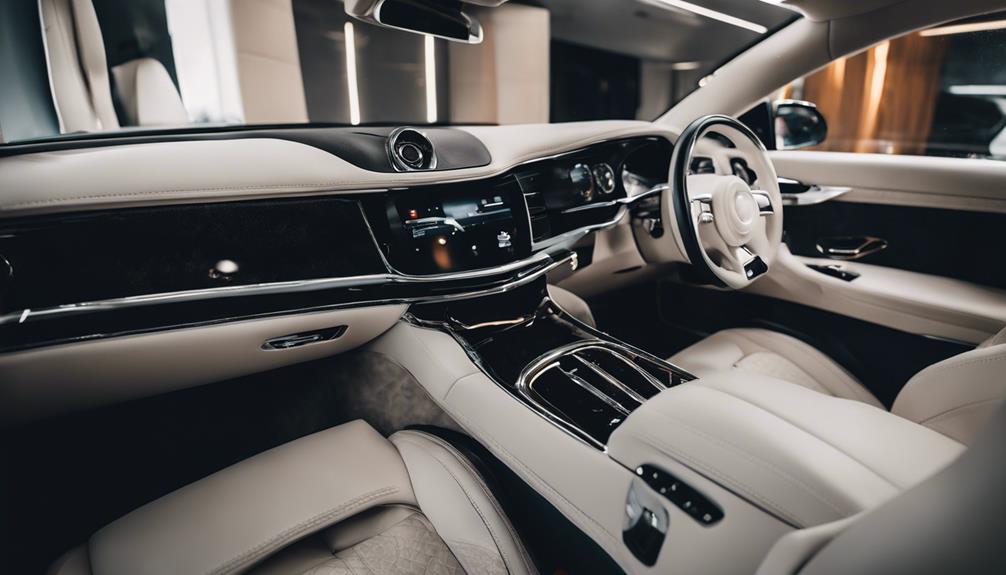
For a superior interior cleaning experience, consider our premium detailing options that cater to luxury vehicles and offer specialized services for a thorough and meticulous clean. Our premium interior detailing services utilize advanced techniques such as a pneumatic system for debris removal and a 212 ° F foam generator for deep fabric cleaning.
Here are three reasons why our premium interior cleaning options stand out:
- Specialized Services: We provide specialized services like smoke and odor removal using the DrivePur Protection System and T102 Titanium Dioxide starting at $49.
- Hair Removal and Leather Repair: Enjoy a hair removal service starting at $39 and expert leather repair starting at $139 to keep your interior looking pristine.
- Luxury Vehicle Treatment: Our services cater to luxury car brands like Bentley, Ferrari, Lamborghini, Porsche, and Rolls Royce, ensuring they receive preferred treatment for a truly premium experience.
When it comes to cleaning your car's interior, our premium options go above and beyond, using hot water and specialized equipment to give your vehicle the royal treatment it deserves.
Mobile Car Wash Services Available
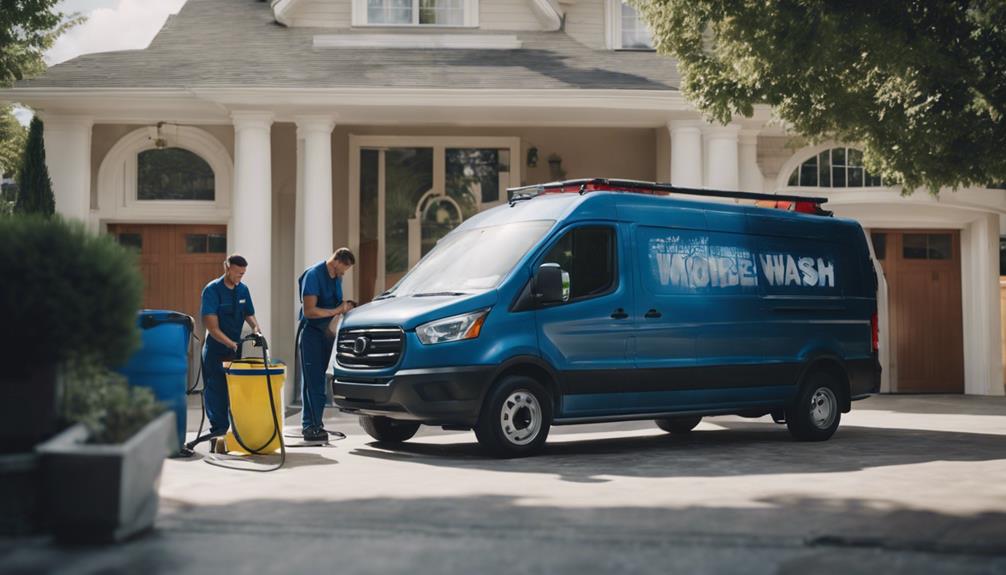
Considering our premium interior cleaning options, you can now explore the convenience and flexibility of our mobile car wash services available to cater to your busy schedule. Our mobile services bring interior detailing right to your doorstep, offering you the ultimate convenience.
With valet mobile services for pick up and drop off, getting your car cleaned has never been easier. Imagine having unlimited car washes on the go with our membership plans, ensuring your vehicle always looks its best effortlessly.
Additionally, by choosing our mobile services, you aren't only benefiting from convenient solutions but also supporting the Care for a Child's Heart Foundation as we give back to the community. Operating from 8:00 am to 6:00 pm, our flexible service hours accommodate your needs seamlessly.
Experience the ease of getting your car meticulously cleaned without disrupting your day – our mobile services are here to make your life simpler and your car sparkling clean.
Full Detailing With Shampooing Services
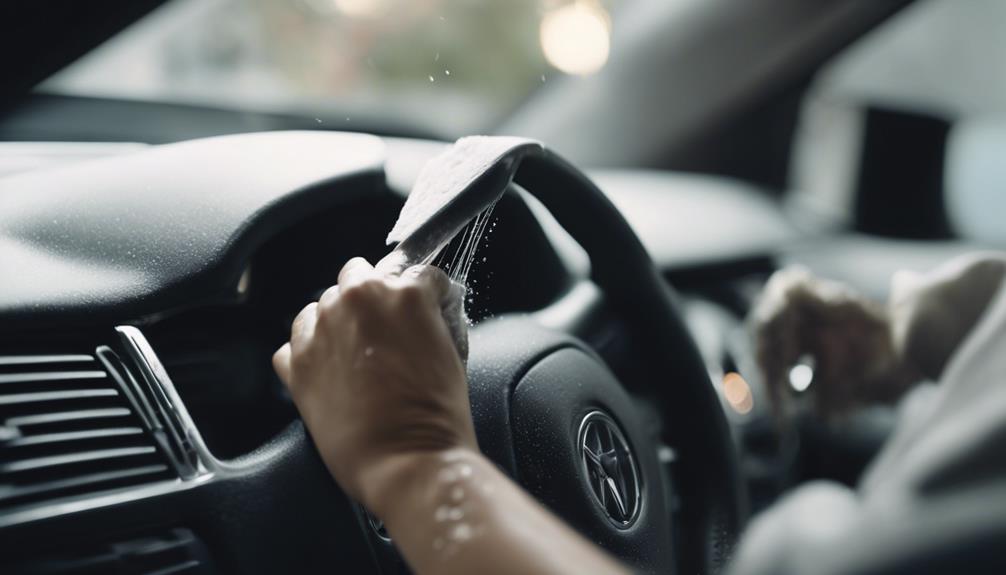
When it comes to getting your car's interior spotless, full detailing with shampooing services is the way to go.
Discover the benefits of shampooing, learn essential tips for cleaning interior fabrics, and explore the techniques used by professionals for a high-quality finish.
Say goodbye to stubborn stains and odors, and hello to a fresh and revitalized interior with expert detailing services!
Shampooing Benefits Explained
Shampooing as part of full detailing services effectively removes deep-seated dirt, stains, and odors from your car's interior. Here are three reasons why shampooing is beneficial for your car:
- Thorough Cleaning: Specialized cleaning solutions and equipment guarantee a deep and thorough clean, leaving your car looking and smelling fresh.
- Restoration: Shampooing helps rejuvenate carpets, upholstery, and fabric surfaces, restoring their appearance and extending their lifespan.
- Hygiene: By targeting tough stains, spills, pet hair, and allergens, shampooing promotes a clean and healthy interior environment for you and your passengers.
Investing in professional shampooing services as part of detailing packages offers a holistic solution for maintaining a pristine car interior.
Interior Fabric Cleaning Tips
To enhance the cleanliness and freshness of your car's interior, incorporating fabric cleaning tips into your full detailing routine with shampooing services is vital. When cleaning your car's interior fabric, remember to use specialized products and equipment to guarantee a thorough and effective cleaning process. Here are some tips to help you achieve the best results:
| Fabric Cleaning Tips | Description | Benefits |
|---|---|---|
| Use a gentle brush | Gently scrub the fabric to remove dirt and stains | Prevents damage to the fabric |
| Vacuum first | Remove loose dirt and debris before cleaning | Allows for a deeper clean |
| Test in inconspicuous area | Ensure the cleaning product doesn't harm the fabric | Avoid potential discoloration |
| Follow product instructions | Use the right amount of product for effective cleaning | Prevents over-saturation |
| Allow to dry completely | Make sure the fabric is fully dry before using the car | Prevents mold and mildew growth |
Professional Detailing Techniques
For professional detailing techniques that guarantee a pristine interior, expert detailers employ specialized equipment and products to thoroughly clean and revitalize your car's surfaces. When opting for full detailing with shampooing services, you can expect:
- Thorough Interior Cleaning: Professional detailers go beyond surface cleaning, ensuring seats, carpets, and mats are deeply cleaned with specialized shampoos.
- Leather Surface Treatment: Services may include conditioning and deep cleaning of leather surfaces to bring back their original luster and softness.
- Stain and Odor Removal: Expert detailers use specialized products to efficiently eliminate tough stains and odors, leaving your car smelling fresh and looking brand new.
These techniques not only enhance the appearance but also create a hygienic environment inside your vehicle.
Membership Plans for Unlimited Washes

Consider opting for a membership plan to enjoy unlimited car washes at your convenience. These plans can save you time and money while keeping your vehicle looking its best. Take a look at the table below to compare different membership options available:
| Membership Plan | Price | Benefits |
|---|---|---|
| Basic | $25/month | Unlimited exterior washes |
| Premium | $40/month | Unlimited exterior and interior washes |
| VIP | $60/month | Unlimited exterior and interior washes, valet services for pick-up and drop-off |
Membership plans not only offer great value but also ensure that your car stays clean without the hassle of scheduling individual washes. Plus, with valet services provided, you can have your car cleaned while you go about your day. So, why not simplify your car maintenance routine and sign up for a membership plan today?
Community Support Initiatives Offered

Considering your interest in our membership plans for unlimited car washes, it's worth noting the active community support initiatives we offer. These initiatives aren't only about keeping your car clean but also about giving back to the community. Here are a few ways we support the community:
- Valet Mobile Services: We provide convenient pick-up and drop-off services, making it easier for you to get your car washed without disrupting your busy schedule.
- Membership Plans: By offering unlimited washes for regular customers, we guarantee that you can keep your car clean while also supporting our community initiatives like the Care for a Child's Heart Foundation.
- Business Hours: Our extended hours from 8:00 am to 6:00 pm allow for accessibility to customers, ensuring you can always find time to support our community efforts.
At our establishment, we take pride in not only providing excellent car wash services but also in making a positive impact on the community.
Specialized Odor Removal Techniques

When it comes to tackling stubborn odors in your car, specialized techniques are key.
Professional cleaning methods like deep cleaning and sanitization with eco-friendly dry-steam can effectively eliminate unwanted smells.
Odor Elimination Techniques
To effectively eliminate stubborn odors from your car interior, specialized techniques like using products such as DrivePur Protection System and T102 Titanium Dioxide are crucial. These techniques target specific odors like smoke, pet smells, and other persistent odors. When dealing with unpleasant smells in your car, consider the following specialized odor elimination techniques:
- DrivePur Protection System: This product uses advanced technology to neutralize odors at the molecular level, leaving your car smelling fresh and clean.
- T102 Titanium Dioxide: Known for its powerful odor-absorbing properties, T102 Titanium Dioxide can effectively eradicate even the toughest odors from your car interior.
- Thorough Cleaning: Combine specialized products with a thorough cleaning regimen to ensure all surfaces are treated and sanitized, effectively eliminating odors from your car.
Professional Cleaning Methods
Eliminating stubborn odors from your car interior requires professional cleaning methods that employ specialized odor removal techniques like the DrivePur Protection System and T102 Titanium Dioxide.
The DrivePur Protection System harnesses advanced technology to neutralize and eliminate persistent odors effectively. On the other hand, T102 Titanium Dioxide acts as a potent component that targets and breaks down odor-causing molecules, ensuring a fresh and clean environment inside your vehicle.
These specialized techniques guarantee thorough and long-lasting odor removal, leaving your car interior smelling clean and fresh. Professional detailers utilize these advanced methods to tackle tough odors, enhancing the overall cleanliness and comfort of your vehicle.
Say goodbye to unpleasant odors and welcome a rejuvenated car interior with these specialized odor removal techniques.
Leather Repair and Restoration Services
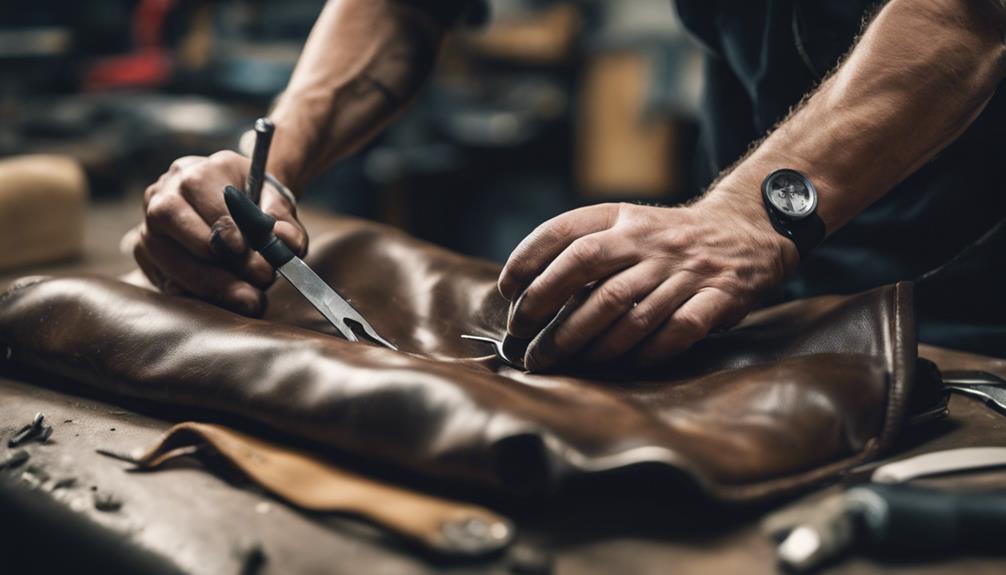
Leather repair and restoration services offer a range of specialized treatments tailored to luxury car brands like Bentley, Ferrari, Lamborghini, Porsche, and Rolls Royce. These services include dyeing, repair processes, conditioning, and protection cream application to guarantee your leather interior looks pristine. The restoration services cater specifically to high-end vehicles, providing deep cleaning, repair, and protection techniques to maintain the luxurious feel of your car.
Here are three key benefits of opting for leather repair and restoration services:
- Preservation of Luxury: By investing in these services, you can extend the lifespan of your leather interior, preserving the elegance and sophistication that comes with luxury car brands.
- Enhanced Aesthetics: Through specialized treatments, your leather interior can regain its original beauty, removing signs of wear and tear and bringing back the luxurious look.
- Value Retention: Regular repair and restoration services help maintain the value of your luxury vehicle, ensuring that it stays in top condition for years to come.
Consider these services to keep your luxury car looking its best.
Spot Stain Removal Solutions
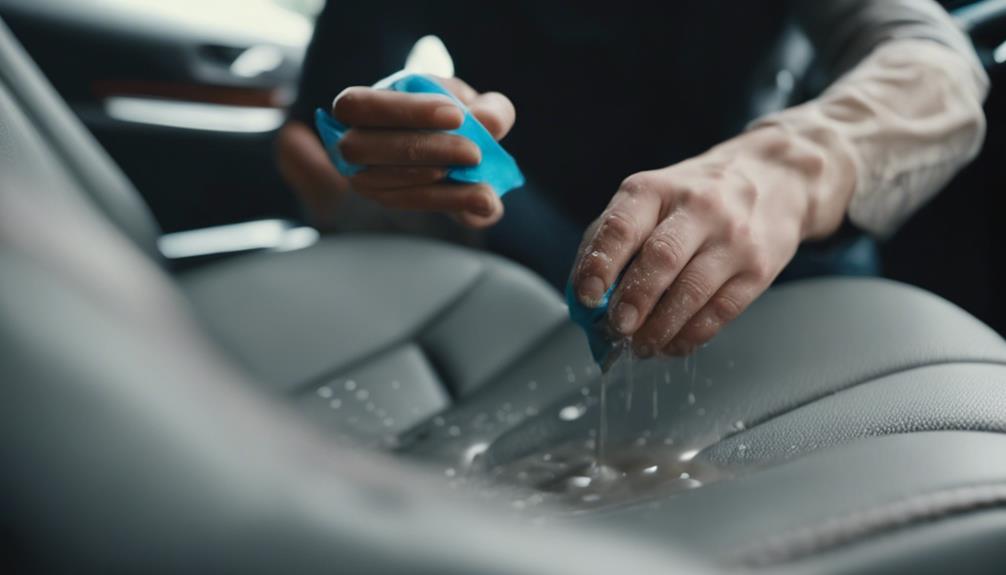
When dealing with stubborn stains in your car's interior, quick stain removal solutions are key to keeping your vehicle looking fresh and clean. From DIY cleaning hacks to recommended products, there are various ways to tackle those pesky spots effectively.
Whether it's a coffee spill on your carpet or a grease mark on your seat, knowing the right techniques can help you maintain a spotless interior.
Quick Stain Removal
Utilizing specialized equipment and targeted products, spot stain removal services provide effective solutions for removing specific stains like coffee, wine, grease, and pet accidents from your car's interior.
Here are three reasons why quick stain removal services are a game-changer:
- Efficiency: Professional detailers use advanced techniques to swiftly tackle stubborn stains, saving you time and effort.
- Precision: With their expertise, they can identify the best approach for each type of stain, ensuring thorough removal without causing damage.
- Enhanced Appearance: By ridding your car of unsightly stains, these services help restore the freshness and beauty of your vehicle's interior, making it look and feel brand new.
DIY Cleaning Hacks
To keep your car interior looking fresh and clean, try these DIY Cleaning Hacks for spot stain removal solutions.
For stubborn stains like coffee or wine spills, create a mixture of vinegar and water.
Sprinkle baking soda on fabric surfaces to absorb odors, then vacuum it up for a fresher interior.
Use club soda to lift stains from upholstery by gently dabbing it with a cloth and blotting it dry.
Combat grease stains on surfaces like cup holders or door panels by mixing lemon juice with baking soda to create a natural paste.
Clean and disinfect hard surfaces like steering wheels or gear shifts in your car effectively by using rubbing alcohol on a cloth.
Keep your car looking spotless with these simple and effective DIY cleaning hacks.
Product Recommendations
Looking for effective spot stain removal solutions for your car interior? When dealing with tough stains like coffee spills, food stains, or pet accidents, you need reliable products that can get the job done. Here are some recommendations to help you tackle those stubborn spots:
- Multi-Surface Safety: Opt for spot stain removal products that are safe for various materials such as fabric, leather, and vinyl. This guarantees effective stain removal without causing damage.
- Enzymatic Power: Consider stain removers with enzymatic formulas that target organic stains like pet urine, blood, and food residues. These formulas break down tough stains for a thorough clean.
- Convenient Application: Look for products available in spray bottles or wipes for easy application and quick cleanup of minor stains on car upholstery and carpets.
Before and After Interior Cleaning Shots

Witness the dramatic transformation captured in the before and after interior cleaning shots, showcasing the remarkable removal of stains and dirt from seats, carpets, and mats. These visual references serve as powerful testimonials to the effectiveness of the interior cleaning service. The images reveal a striking change from a grimy, worn-out interior to one that looks almost brand new. By comparing the before and after shots, you can see how the cleaning process not only eliminates visible stains but also revitalizes the entire surface, making it look fresh and well-maintained.
The pictures highlight the thoroughness and quality of the interior cleaning results. They demonstrate how professional cleaning can bring back the original color and texture of your car's interior elements. From spilled drinks on the seats to mud on the carpets, the transformation is truly impressive. These shots provide tangible proof of the service's capability to restore your car's interior to its former glory. So, next time you consider getting your car cleaned, remember to check out these before and after shots for a preview of the fantastic results you can expect.
Frequently Asked Questions
How Do You Wash the Inside of a Car?
To wash the inside of a car, start by vacuuming to get rid of dirt and dust.
Next, use an interior cleaner to wipe down surfaces like the dashboard and door panels.
For deep cleaning, shampoo carpets and upholstery.
Don't forget to clean and condition leather or vinyl to keep them looking sharp.
Use brushes, cloths, and swabs for those hard-to-reach spots.
With these steps, your car's interior will shine like new!
How Much Does Car Detailing Cost in Houston?
Car detailing costs in Houston vary based on your car's size and condition, ranging from $50 for basic services to $340 for a full interior cleaning. Additional specialized services like smoke and odor removal (starting at $49) and leather repair (beginning at $139) cater to specific needs.
Premium detailing services are available for luxury brands like Bentley and Ferrari. Different packages, such as Super Clean and Full Detail, offer a variety of services to suit your preferences and budget.
Is It OK to Clean the Interior of a Car?
Cleaning the interior of your car isn't only essential but vital for a pleasant driving experience. It helps remove dirt, grime, and bacteria, maintaining a hygienic environment.
Regular cleaning also enhances passenger comfort and boosts the car's resale value. Using specialized products and tools for tasks like vacuuming, wiping, and conditioning guarantees effective results.
What Is the Best to Clean the Interior of a Car?
To clean the interior of your car effectively, start by removing loose items and vacuuming thoroughly. Use proper tools and products to shampoo seats, carpets, and floor mats for a deep clean.
Clean plastic and leather surfaces with suitable agents to remove dirt and grime. Guarantee streak-free windows and mirrors by using the right solutions.
Professional services range from $200 to $340 based on your vehicle's size and condition.
Conclusion
So, next time your car's interior needs a good cleaning, head over to our professional detailing services for a high-quality experience.
With premium cleaning options, mobile services, and even membership plans for unlimited washes, we've got everything you need.
Say goodbye to those pesky stains and odors with specialized techniques and leather repair services. Your car will look and smell brand new in no time!
Don't miss out on the chance to give your ride some TLC.
Interior
Where Can I Take My Car to Get the Interior Cleaned
Get your car's interior sparkling clean with professional detailing services in Houston, starting with the letter "G"…

Looking to refresh your car’s interior in Houston? Explore YRK CUSTOMZ for highly-rated detailing services specializing in cars and SUVs. They offer O3-Ozone treatment for odor elimination and even provide convenient mobile options. Want to compare prices? Local centers in Houston offer affordable detailing packages with various services to meet your needs. For specialized techniques like foam generators and ozone treatment, professional detailing is the best choice. And for a combo deal, jAAN Car Care Center CA provides expert interior and exterior cleaning services with available discount codes. Enhance the look of your car today!
Key Takeaways
- YRK CUSTOMZ in Houston offers top-rated interior detailing services for cars and SUVs.
- Mobile detailing services bring professional cleaning to your doorstep for convenience.
- Compare affordable interior detailing packages at local centers in Houston.
- Specialized cleaning techniques like ozone treatment and foam generators available for thorough cleaning.
- Newly added jAAN Car Care Center CA offers detailed interior cleaning with discounts available.
Top-Rated Interior Cleaning Services in Houston
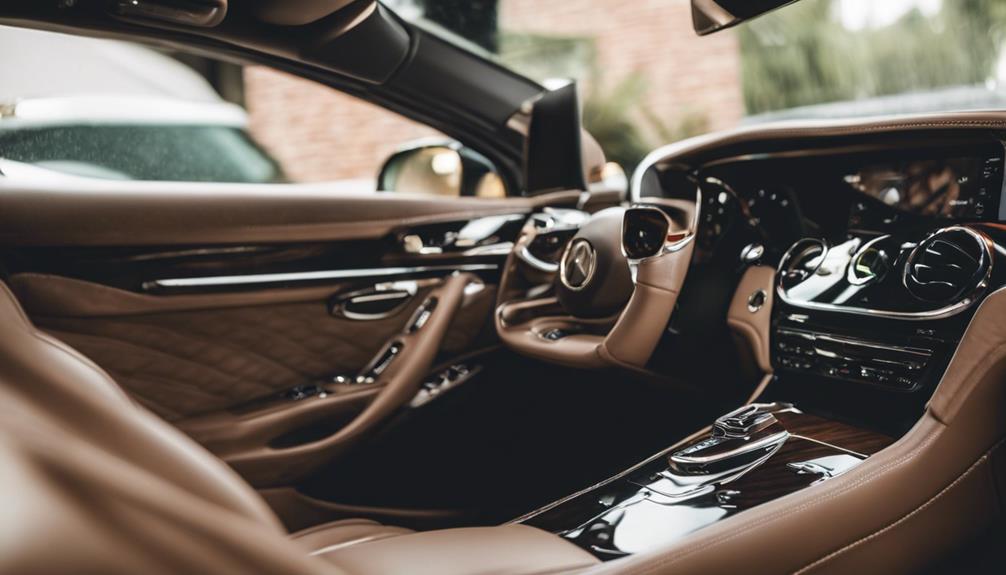
When looking for top-rated interior cleaning services in Houston, consider YRK CUSTOMZ for their 4.7-star rated detailing services. YRK CUSTOMZ specializes in interior detailing and restorative cleaning for cars and SUVs. Their team of skilled interior cleaners will leave your vehicle looking fresh and rejuvenated. Whether you need a quick touch-up or a deep clean, YRK CUSTOMZ is the place to go for premium car detailing.
At YRK CUSTOMZ, you can experience the ultimate auto spa treatment with their O3-Ozone treatment, designed to eliminate odors and bacteria, leaving your car's interior smelling clean and fresh. They offer sedan detailing services that will make your car's interior look as good as new. Additionally, YRK CUSTOMZ provides convenient mobile detailing options, ensuring that your car receives the care it deserves wherever you are.
Trust YRK CUSTOMZ as your go-to destination for exceptional car interior cleaning services in Houston. With their expertise and 4.7-star rating, you can rest assured that your vehicle is in good hands.
Convenient Mobile Interior Detailing Options
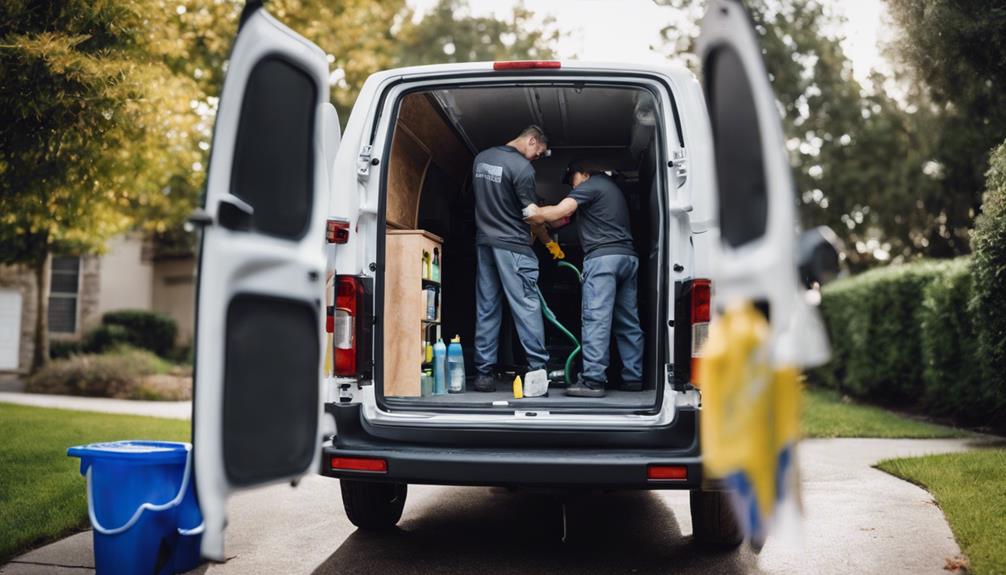
For hassle-free car interior cleaning, consider opting for convenient mobile detailing services that bring professional cleaning right to your doorstep.
These mobile options offer a convenient solution for busy individuals who want their car interiors cleaned without the need to travel. Professional detailing experts arrive equipped with advanced tools and equipment to guarantee a thorough cleaning process.
In addition to basic cleaning services, many mobile detailing services also provide additional treatments such as odor removal and stain treatment to address specific issues in your car interior.
When it comes to pricing, the cost of mobile interior detailing can vary depending on the service provider and the specific package you choose. By selecting a mobile detailing service, you can enjoy the convenience of professional interior cleaning without having to leave your home or office, making it a practical choice for those seeking efficient and effective car cleaning solutions.
Affordable Interior Detailing Packages Near Me

Looking for affordable interior detailing packages near you? Compare pricing options and keep an eye out for local detailing specials to get the best deal possible.
Local car detailing centers in Houston offer a range of services at varying prices, so you can find the perfect package to suit your budget and needs.
Pricing Options Comparison
Explore a range of affordable interior detailing packages near you to compare pricing options for restoring your car's interior to a pristine condition.
When looking for cost-effective options, consider the following:
- Basic Package ($50-$70): Includes vacuuming, dusting, and window cleaning.
- Standard Package ($80-$100): Adds carpet shampooing and seat conditioning to the basic services.
- Premium Package ($120-$150): Offers complete interior detailing with leather treatment and odor elimination.
Local Detailing Specials
Discovering nearby detailing specials can help you save on interior cleaning while ensuring your car looks its best. Consider these discounted packages for cars and SUVs to give your vehicle the care it deserves:
| Detailing Service Provider | Vehicle Type | Service Offered | Discounted Price | Regular Price |
|---|---|---|---|---|
| YRK CUSTOMZ | Cars and SUVs | Interior Detailing | $86.40 | $135 |
| Xcellent Mobile Services | Cars or Small SUVs | Mobile Exterior Detail | $100 | $200 |
| Car Toys | Vehicles | Interior Detailing with O3-Ozone Treatment | $79.99 | $129.99 |
| Indris Car SPA | Sedan/Coupe | Detailing | $172.50 | $250 |
| Quoontry | Cars | Interior and Exterior Detailing | $138 | $200 |
Take advantage of these local detailing specials to keep your car looking fresh inside and out!
Specialized Interior Cleaning Techniques Available

When it comes to specialized interior cleaning techniques, advanced methods and customized treatments are essential to achieving exceptional results. These techniques go beyond traditional cleaning to address specific issues like smoke and odor removal, leather repair, and stain removal.
Advanced Cleaning Methods
Advanced interior cleaning methods in car detailing services often utilize specialized techniques like pneumatic driven systems and high-temperature foam generators for deep fabric cleaning. These advanced methods guarantee a thorough cleaning experience, particularly for luxury car brands. Here are three key aspects of advanced cleaning methods:
- Pneumatic Driven Systems: Utilized for effective debris removal during interior cleaning processes.
- 212 ° F Foam Generator: Essential for deep fabric cleaning, ensuring a high level of cleanliness.
- Eco-Friendly Euro Dry-Steam: Employed for sanitization in premium interior detailing services, providing a thorough and environmentally conscious cleaning solution.
With these specialized techniques, your car's interior will receive exceptional care, leaving it looking and feeling fresh and rejuvenated.
Customized Interior Treatments
For a truly personalized interior cleaning experience, consider exploring the range of specialized techniques available for customized treatments.
Specialized interior cleaning techniques include pneumatic driven systems for efficient debris removal and eco-friendly dry-steam sanitization at 212°F, ensuring a thorough and environmentally friendly clean.
Premium interior detailing services cater to luxury car brands like Bentley, Ferrari, Lamborghini, Porsche, and Rolls Royce, providing excellent care for high-end vehicles.
Additional services such as smoke and odor removal using the advanced DrivePur Protection System, and leather repair starting at $139 are also available.
Spot stain removal services equipped with industrial standard cleaning equipment guarantee a meticulous cleaning process for all types of stains.
Certification details highlight technician qualifications, annual training, and a network of detailers for quality assurance and expertise in specialized techniques.
Ozone Treatment for Interior Odor Removal

To effectively eliminate stubborn interior odors in your car, consider ozone treatment as a powerful and eco-friendly solution. Here are three key points to understand why ozone treatment is a great choice for odor removal in vehicles:
- Potent Odor Elimination: Ozone treatment works by using ozone gas to penetrate your car's interior and neutralize odor-causing molecules. This process effectively eliminates tough odors like smoke, pets, food, mold, and more, leaving your car smelling fresh and clean.
- Non-Toxic and Eco-Friendly: Ozone treatment is a safe and environmentally friendly method for removing odors. It doesn't involve the use of harsh chemicals, making it a preferred choice for those seeking a natural and environmentally friendly solution.
- Professional Detailing Services: Many professional detailing services offer ozone treatment as an add-on service for thorough interior cleaning. This service ensures that your car not only looks clean but also smells fresh and pleasant, providing lasting results for your driving comfort.
Sedan and Coupe Interior Detailing Services

When considering sedan and coupe interior detailing services in Houston, explore a variety of top-rated options to guarantee a thorough cleaning experience for your vehicle. YRK CUSTOMZ, jAAN Car Care Center, and other locations offer interior detailing for sedans and coupes, ensuring that your car's seats, carpets, dashboard, and other surfaces are cleaned meticulously.
Pricing for these services can range from $56.25 to $172.50, with discounts available at select places. For example, jAAN Car Care Center currently provides a discounted rate of $50.63 for both interior and exterior detailing for sedans and coupes when using the code GIFT4MOM. Make sure to take advantage of these offers to keep your vehicle looking its best.
Choose from a range of top-rated auto detailing services in Houston to pamper your sedan or coupe with the cleaning it deserves.
Expert Interior and Exterior Detailing Combos

Interested in spoiling your vehicle with a thorough cleaning session that boosts the appearance of both the interior and exterior surfaces? When it comes to expert interior and exterior detailing combos, there are various services available to give your car a fresh look. Here's what you can expect:
- Full Interior Cleaning: Enjoy a thorough interior cleaning service that includes debris removal using a pneumatic driven system and deep fabric cleaning with a hot water extractor reaching 212°F.
- Restorative Interior Cleaning: Treat your car to restorative services like smoke and odor removal utilizing the DrivePur Protection System, and affordable leather repair starting at $139.
- Additional Touches: Take advantage of spot stain removal, hair removal service starting at $39, and a price match policy for your satisfaction.
With these offerings, your car will receive the attention it deserves, from fabric cleaning to leather repair, ensuring a fresh and revitalized interior that you can enjoy.
Newly Added Car Care Center for Interior Cleaning

Spoil your vehicle with a detailed interior and exterior cleaning session at the newly added jAAN Car Care Center CA, conveniently located just 16.4 miles from Houston. This car care center specializes in providing excellent cleaning services for Sedans and Coupes.
With a regular price of $75, you can enjoy a discounted rate of $56.25. But wait, there's more! By using the code GIFT4MOM, you can access an additional discount, bringing the cost down to just $50.63. This fantastic offer has already attracted over 10 satisfied customers today.
Whether your car needs a thorough interior cleaning or a sparkling exterior touch-up, jAAN Car Care Center CA has got you covered. Say goodbye to dirt, dust, and grime, and hello to a fresh and pristine vehicle interior. Don't miss out on this opportunity to give your car the pampering it deserves. Visit the newly added car care center in Houston and let your vehicle shine inside out!
Discounted Prices for Interior Detailing Services
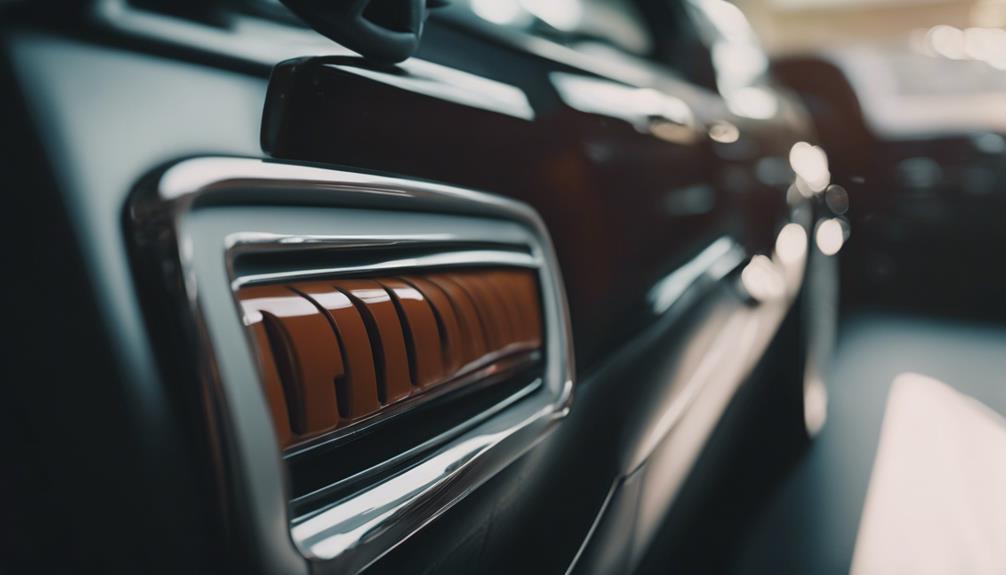
Indris Car SPA is currently offering a discounted price of $172.50 for sedan/coupe detailing services, reduced from the regular price of $250. If you're looking to get your car/SUV sparkling clean, check out these fantastic discounted interior detailing services:
- YRK CUSTOMZ provides interior detailing for cars/SUVs at a discounted price of $86.40, down from $135.
- Xcellent Mobile Services offers a mobile exterior detail package for cars or small SUVs at a discounted price of $100, originally priced at $200.
- Car Toys presents an interior detailing package with O3-Ozone treatment at a discounted rate of $79.99, reduced from $129.99.
With these great deals, you can give your vehicle the pampering it deserves without breaking the bank. Whether you need a thorough interior and exterior cleaning service or a specialized detail package, these discounted rates make it easier to keep your car looking its best.
Frequently Asked Questions
How Much Does It Take to Clean the Inside of a Car?
Cleaning the inside of a car typically takes 4 to 8 hours and may require leaving your car for a full day. After the process, around 90% of the interior will be dry at pickup, reducing your wait time.
Odor removal might need an additional treatment, depending on the type of odor in your car. Deep cleaning helps effectively reduce odors.
Specific completion times are given after inspecting your car's interior condition in person.
What Is It Called When You Get the Inside of Your Car Cleaned?
When you get the inside of your car cleaned thoroughly, it's known as interior detailing. This process involves sprucing up various parts like seats, carpets, dashboard, and door panels to make your car's interior look and feel fresh.
Tasks like vacuuming, shampooing, steam cleaning, and leather conditioning are part of interior detailing. Professional services offer different cleaning levels based on your car's interior condition, from full cleaning to restorative treatments.
How Much Does Car Detailing Cost in Houston?
Car detailing costs in Houston can vary, ranging from $75 to $250. Popular services like YRK CUSTOMZ and Xcellent Mobile Services offer competitive pricing. You can even find discounts of up to 31% on interior cleaning packages.
New options like jAAN Car Care Center CA provide affordable deals. With prices as low as $56.25 with promo codes, getting your car detailed in Houston is both convenient and cost-effective.
How Can I Clean My Car Interior Cheaply?
If you're looking to clean your car interior on a budget, consider DIY solutions like vinegar and baking soda. You can also find affordable services at local car washes or detailing shops. Keep an eye out for coupons or promotions to save even more.
Bundled packages that include exterior wash can help you cut costs. Opt for basic interior cleaning without extras for a wallet-friendly choice.
Conclusion
To sum up, when it comes to getting your car's interior cleaned in Houston, you have a variety of top-rated options to choose from. Whether you prefer convenient mobile detailing or specialized cleaning techniques, there's a service for you.
Don't forget to check out the newly added car care center for discounted prices on interior detailing services. So why wait? Take your car in for a thorough cleaning and enjoy a fresh and sparkling interior in no time!
-

 Vetted8 months ago
Vetted8 months ago15 Best EMS Foot Massagers for Neuropathy to Soothe Your Feet
-
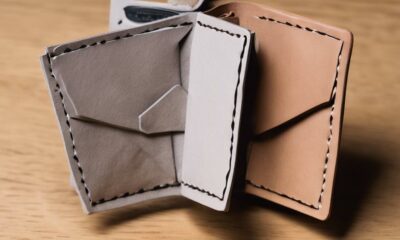
 Vetted7 months ago
Vetted7 months ago14 Best Personalized Father's Day Gifts for Your Husband – Show Him You Care
-

 Alfresco7 months ago
Alfresco7 months agoAlfresco Stacker Doors: Seamless Indoor-Outdoor Living!
-
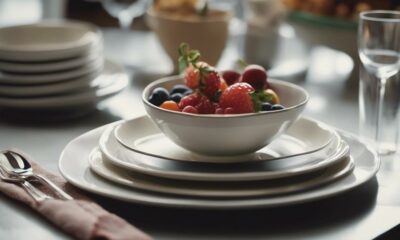
 Tableware and Dining Accessories2 weeks ago
Tableware and Dining Accessories2 weeks agoWhat Is the Meaning of the Word Tableware
-

 Tableware and Dining Accessories2 weeks ago
Tableware and Dining Accessories2 weeks agoWhen Is Tableware on Sale at Hobby Lobby
-

 Tableware and Dining Accessories2 weeks ago
Tableware and Dining Accessories2 weeks agoWhich of the Following Is Not Classified as Tableware
-

 Vetted8 months ago
Vetted8 months ago15 Best Detergents for Wool: Keep Your Woolens Looking Fresh and Fabulous
-
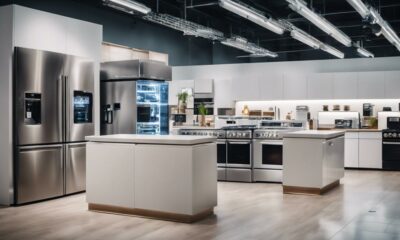
 Craft and Textiles8 months ago
Craft and Textiles8 months ago15 Best Places to Buy Appliances for Your Home – Top Retailers Reviewed





